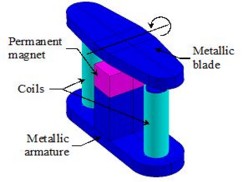3D Example : Magneto Static application (tutorial)
Foreword
This paragraph is a summary of cases treated in detail in the technical document: "Tutorial of magnetostatics".
The files relating to these various cases are available in the documentation directory of the Flux DVD.
Study carried out
The study proposed in the 3D tutorial "Magnetostatics" is the study of a contactor used to establish or break electric circuits.
Studied device
The studied device, represented in the figure below, includes the following elements:
- a fixed part composed of a metallic armature, a permanent magnet placed on the top of a central column and two coils placed around two cylindrical lateral columns
- a movable part composed of a metallic blade

Operation
The operation of this device is as follows:
- when either coil is current supplied, the blade moves to the respective coil (rotating motion around an axis in the figure above)
- when the current supply is interrupted, the blade rests immobile as a result of the existence of the magnetic field created by the permanent magnet.
Studied cases
Three cases are carried out in a Magneto Static application:
- case 1: static study
- case 2: physical parameterized computation
- case 3: geometric parameterized computation
Case 1
The first case is a static study.
In this study a magnetostatic analysis of the contactor with the movable blade tilted to the left is performed. A geometric parameter α, which allows us to control the angle of the blade around Y-axis, has a fixed value α = -3°. The coils are not current supplied.
Case 2
The second case is a physical parameterized computation.
In this parameterized study, the physical parameter is the total current supplying one of the coils that varies in the range [– 300 A, + 300 A] with a step of 100 A.
Case 3
The third case is a geometric parameterized computation.
In this parameterized study, the geometric parameter is the angle α that varies in the range [– 3°, + 3°] with a step of 1°.